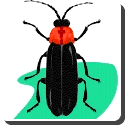 Firefly — Lampyridae is a family in the beetle order Coleoptera, members of which are commonly called fireflies, lightning bugs or (ambiguously) “glow worms” due to their conspicuous nocturnal (or, more accurately, crepuscular) use of bioluminescence to attract mates or prey. Fireflies are capable of producing a “cold light” containing no ultraviolet or infrared rays, with a wavelength from 510 to 670 nanometers, pale reddish, yellowish or green in colour, with a lighting efficiency of up to 96%.
Firefly — Lampyridae is a family in the beetle order Coleoptera, members of which are commonly called fireflies, lightning bugs or (ambiguously) “glow worms” due to their conspicuous nocturnal (or, more accurately, crepuscular) use of bioluminescence to attract mates or prey. Fireflies are capable of producing a “cold light” containing no ultraviolet or infrared rays, with a wavelength from 510 to 670 nanometers, pale reddish, yellowish or green in colour, with a lighting efficiency of up to 96%.
There are more than 2000 species of firefly found in temperate and tropical environments around the world. Many species can be found in marshes or in wet, wooded areas where their larvae have abundant sources of food.
Fireflies tend to be brown and soft-bodied, often with the elytra more leathery than in other beetles. Though the females of some species are similar in appearance to males, larviform females are found in many other firefly species. These females can often be distinguished from the larvae only because they have compound eyes.The most commonly known fireflies are nocturnal, though there are numerous species that are diurnal. Most diurnal species are non-luminescent, though some species that remain in shadowy areas can produce light.
A few days after mating, a female lays her fertilized eggs on or just below the surface of the ground. The eggs hatch 3-4 weeks later and the larva feed until the end of the summer. The larvae are commonly called glowworms, not to be confused with the distinct beetle family Phengodidae or fly genus Arachnocampa. Lampyrid larvae have simple eyes. The term glowworm is also used for both adults and larvae of species such as Lampyris noctiluca, the common European glowworm, in which only the non-flying adult females glow brightly and the flying males glow only very weakly and intermittently. Fireflies overwinter (some species for several years) during the larval stage. Some do this by burrowing underground, while others find places on or under the bark of trees. They emerge in the spring. After several weeks of feeding, they pupate for 1 to 2.5 weeks and emerge as adults. The larvae of most species are specialized predators and feed on other larvae, terrestrial snails, and slugs. Some are so specialized that they have grooved mandibles which deliver digestive fluids directly to their prey. The diet of adults is variable. It has been reported that some are predatory and some feed on plant pollen or nectar.
Light production in fireflies is due to a chemical reaction that occurs in specialized light-emitting organs, usually on the lower abdomen. The enzyme luciferase acts on luciferin in this organ to stimulate light emission. This reaction is of scientific interest. Genes coding for these substances have been inserted into many different organisms (see Luciferase – Applications). Luciferase is also used in forensics, and the enzyme has medical uses.
For adult beetles, it is primarily used to locate other individuals of the same species for reproduction. Many species, especially in the genus Photinus, are distinguished by the unique courtship flash patterns emitted by flying males in search of females. Photinus females generally do not fly, but give a flash response to males of their own species.
Bioluminescence is a very efficient process. Some 90% of the energy a firefly uses to create light is actually converted into visible light. By comparison, an incandescent electric bulb can convert only 10 percent of total energy used into visible light, and the remainder is emitted as heat.
 Kids Portal For Parents India Kids Network
Kids Portal For Parents India Kids Network
